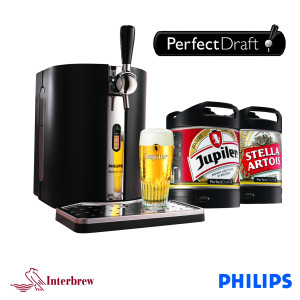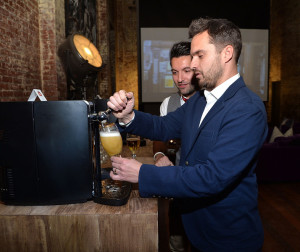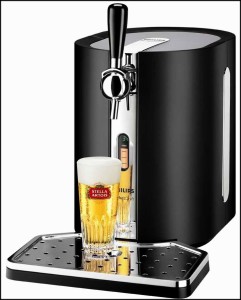 On the evening of Tuesday, March 25, Stella Artois held a celebration at Lafayette Townhouse in Manhattan’s SoHo neighborhood to launch a global pilot program aiming to bring its best-in-class draft experience to the world’s home bars. The evening was hosted by the actor Jake Johnson, star of New Girl on FOX and a home-bar enthusiast in his own right. The centerpiece of the evening was PerfectDraft, a countertop draft system now popular in Europe that will become one feature of the brand’s quest to elevate the home-bar experience around the globe.
On the evening of Tuesday, March 25, Stella Artois held a celebration at Lafayette Townhouse in Manhattan’s SoHo neighborhood to launch a global pilot program aiming to bring its best-in-class draft experience to the world’s home bars. The evening was hosted by the actor Jake Johnson, star of New Girl on FOX and a home-bar enthusiast in his own right. The centerpiece of the evening was PerfectDraft, a countertop draft system now popular in Europe that will become one feature of the brand’s quest to elevate the home-bar experience around the globe.
The home draft system is very much a near-term reality for consumers worldwide. PerfectDraft is popular in Europe, and is now being piloted globally in cities including Sao Paulo, London and New York.
Consumers are drawn to countertop draft systems because they allow them to recreate the bar draft beer experience at home. Stella Artois drinkers in particular have come to expect the beer to be served in its signature Chalice, using the brand’s time-honored 9-step pouring ritual. A system such as PerfectDraft allows them to drink Stella Artois in its finest form in the comfort of their own home.
 “I’d love to serve Stella Artois from a PerfectDraft in my own home bar,” said Jake Johnson. “I do know that people love the bar experience – the crowd, the sounds, the ambience. Bars are beloved, for good reason. So any movement to recreate that experience at home is one worth supporting.”
“I’d love to serve Stella Artois from a PerfectDraft in my own home bar,” said Jake Johnson. “I do know that people love the bar experience – the crowd, the sounds, the ambience. Bars are beloved, for good reason. So any movement to recreate that experience at home is one worth supporting.”
Guest bartender Allaine Schaiko, reigning Stella Artois World Draught Master, gave attendees lessons on home draft pouring skills using the PerfectDraft. Interest was high, in part because the home draft space has grown sharply in popularity in recent years.
The Rise of the U.S. Home Bar: A Study
The United States has seen a surge in home bar interest over the past year. Stella Artois today released the results of a study showing that “home bars” represent a surging trend in entertainment. 50% of Americans currently have a dedicated “home bar” section within their living space. Among the 50% who do not, 44% plan to create one within the next year, and a full 86% of the home-bar set are more interested in cultivating it this year than last. The State of the Home Bar study was conducted by Northstar Research. It examined the habits and preferences of 1,000 Americans, and found that home bar enthusiasm has risen sharply over the past year.
 “Stella Artois connoisseurs around the world appreciate the care and craftsmanship that go into every chalice, from the finest ingredients to the time-honored pouring ritual,” said Debora Koyama, global vice president, Stella Artois. “We’re thrilled to be bringing this experience into people’s homes, and especially to have Jake Johnson join us to give people a look at home-bar possibilities. We intend to remake the home bar experience on a global scale, to ensure that consumers never miss the opportunity to drink their favorite beer in the form they prefer.”
“Stella Artois connoisseurs around the world appreciate the care and craftsmanship that go into every chalice, from the finest ingredients to the time-honored pouring ritual,” said Debora Koyama, global vice president, Stella Artois. “We’re thrilled to be bringing this experience into people’s homes, and especially to have Jake Johnson join us to give people a look at home-bar possibilities. We intend to remake the home bar experience on a global scale, to ensure that consumers never miss the opportunity to drink their favorite beer in the form they prefer.”
The State of the Home Bar study found that when given a choice, many Americans enjoy celebrating at home. The average American hosts approximately six parties in their home within a given year. They attend seven house parties located elsewhere. They spend approximately $603 during the course of the year on home parties, including drinks, food and accessories, the study found.
Home bars, once consigned to the basement, are now migrating throughout the living space. While the basement still serves as the bar space for 44% of Americans, 56% report that their home bar is located elsewhere.
Advice for the Home Bartender
 Stella Artois solicited home-bartending advice from Dale DeGroff, a legendary New York City bartender, beverage manager and author who spent much of his illustrious career managing the bar at iconic Manhattan venues including The Rainbow Room and Windows on the World. DeGroff offers the following advice for home bartenders:
Stella Artois solicited home-bartending advice from Dale DeGroff, a legendary New York City bartender, beverage manager and author who spent much of his illustrious career managing the bar at iconic Manhattan venues including The Rainbow Room and Windows on the World. DeGroff offers the following advice for home bartenders:
Keep the lights down low.
Ambience is critical. Retail bars understand the impact that lighting, audio and temperature have on the consumer experience; get one of them wrong, and the bar will empty out. Bright lights send a subconscious message that the party is ending, so keep the lights low throughout the party, then turn them up and cut the music when the party needs to wind down.
Make your home bar accessible from different angles.
At a certain point in all gatherings, the home bar becomes serve-yourself, and it should be easy to access. Use a table large enough to accommodate drinks and a selection of food. A six-foot table is the ideal size for a home bar.
Invest in multi-purpose devices.
 Space is always at a premium, particularly in major cities, where apartment living requires a degree of creativity. An ice bucket (covered) is a must-have because it can easily be repurposed. And smart home bartenders should look into a device like the Bar10der, which can serve as a bottle opener, a knife, a muddler, a strainer, a corkscrew and more.
Space is always at a premium, particularly in major cities, where apartment living requires a degree of creativity. An ice bucket (covered) is a must-have because it can easily be repurposed. And smart home bartenders should look into a device like the Bar10der, which can serve as a bottle opener, a knife, a muddler, a strainer, a corkscrew and more.
Ensure easy access to the kitchen.
The fact that home bars are slowly but surely migrating up from the basement to different rooms in the house is a positive trend. The closer to the kitchen, the easier it will be to run your home bar. You’ll need ice, running water and food throughout the evening, so minimize the steps necessary to secure them. Choose a spot that has easy flow from more than one direction and set your bar table there.
Serve lots of food.
Moderation is key. Ensure that food is available throughout the party, keep the dips, chips and crudite refreshed, and remind your guests to eat.
Study Methodology
The State of the Home Bar study was conducted on behalf of Stella Artois by Northstar, a globally integrated strategic insights consulting firm, among 1000 Americans over age 25. Surveys were completed on March 18, 2014. Sampling quotas were used to ensure the sample is representative of the US population in terms of age, gender, and region. Assuming a probability sample, the margin of error would be +/-3.1 percentage points, 19 times out of 20.

You must be logged in to post a comment Login